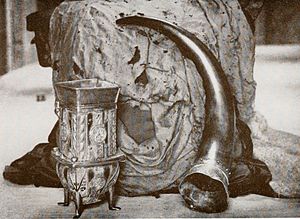Clan MacLeod facts for kids
Quick facts for kids Clan MacLeod |
|||
|---|---|---|---|
| Clann MhicLeòid | |||

Crest: A bull's head cabossed sable, horned Or, between two flags gules, staved at the first
|
|||
| Motto | Hold fast | ||
| Profile | |||
| District | Inner Hebrides, Outer Hebrides, Sutherland | ||
| Plant badge | Juniper | ||
| Chief | |||
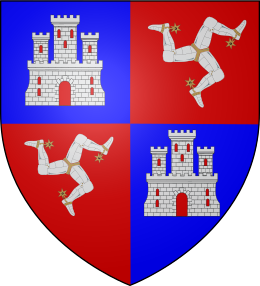 |
|||
| Hugh Magnus MacLeod of MacLeod | |||
| 30th Hereditary Chief Clan MacLeod Chief of the Name and Arms of MacLeod (MacLeòid) | |||
| Seat | Dunvegan Castle | ||
| Historic seat | Dunvegan Castle | ||
|
|||
|
|||
|
|||
|
|||
The Clan MacLeod is a famous Highland Scottish clan from the Isle of Skye. There are two main parts of the clan. The MacLeods of Harris and Dunvegan are called Sìol Tormoid in Gaelic. This means "seed of Tormod". Their chief is MacLeod of MacLeod.
The Clan MacLeod of Lewis and Raasay are called Sìol Torcaill in Gaelic. This means "seed of Torcall". Their chief is MacLeod of The Lewes. Both groups believe they are descended from a man named Leod, who lived in the 1200s.
Today, these different MacLeod clans work together. They are part of the "Associated Clan MacLeod Societies". These societies are found in many countries around the world. This includes Australia, Canada, England, France, Germany, New Zealand, Scotland, South Africa, Switzerland, and the United States.
Contents
History of the Clan MacLeod
Where the MacLeods Came From
The name MacLeod means 'son of Leod'. Leod is a Scottish Gaelic name. It might come from an old Norse word. Clann means "children" or "descendants". Mhic means "son of". So, Clan MacLeod means "The children of the son of Leod".
Clan MacLeod of Lewis believes they came from Leod. Tradition says Leod was a younger son of Olaf the Black. Olaf was the King of Mann from 1229 to 1237. However, some newer ideas suggest Leod was related to the Kings of Mann in a different way.
MacLeod stories say that Leod owned Harris and part of Skye. He married the daughter of a Norse leader on Skye. Leod's two sons, Tormod and Torquil, started the two main branches. These are Siol Tormod and Siol Torquil.
Actually, Torquil was Tormod's grandson. Torquil's family ruled the Isle of Lewis until the 1600s. Then the Mackenzies took over. The MacLeods of Harris (Siol Tormod) helped them. Siol Tormod kept their lands in Harris and Glenelg. They also held Dunvegan on the Isle of Skye. Leod is said to have died around 1280. He was buried on the holy island of Iona. Many chiefs after him were also buried there.
The 1300s: Early Chiefs
Tormod, Leod's son, is not in old records. But MacLeod stories say he was a great soldier. He was supposedly at the Battle of Bannockburn. Tormod's son, Malcolm, is the first MacLeod chief in official records. He and his relative, Torquil, are mentioned in a royal paper from about 1343. This was during the time of King David II.
Malcolm's oldest son, Iain Ciar, became the fourth chief. Clan stories say Iain Ciar was a very strict chief. His wife was also said to be very harsh. Tradition says he was hurt in a surprise attack on Harris. He died from his wounds at the church at Rodel.
Stories also say that another clan, the MacDonalds, attacked Skye in 1395. But Iain's grandson, William MacLeod, fought them. He pushed them back to Loch Eynort. The MacDonalds found their ships had been moved away. So, all the attackers were killed.
1400s: Clan Fights
The Battle of Harlaw happened in 1411. The MacLeods fought as Highlanders. They supported Domhnall of Islay, Lord of the Isles, the chief of Clan Donald.
The Battle of Bloody Bay was fought in 1481. The Clan MacLeod supported John of Islay, Earl of Ross. He was the chief of Clan Donald. They fought against his son, Angus Og Macdonald. William Dubh MacLeod, the chief of Clan MacLeod, died in this battle.
1500s: More Clan Fights
During the 1500s, the Clan MacLeod had many fights. They often feuded with the Clan Macdonald of Sleat.
In 1588, William MacLeod of Dunvegan was the 13th chief. He made an agreement to help and defend Lachlan Mackintosh. Lachlan was the chief of the Clan Chattan.
1600s: Peace and Civil War
The Battle of Coire Na Creiche happened in 1601 on Skye. The MacLeods were defeated by the Clan MacDonald of Sleat. In 1608, after many years of fighting, the clan chiefs met. They met with Lord Ochiltree, who represented the King. They talked about how the King wanted to rule the islands. The chiefs did not agree with the King. So, they were all put in prison. Donald, the chief of Clan MacDonald of Sleat, was held in Blackness Castle. He was set free when he finally agreed to the King's rules.
During the Civil War, many MacLeods fought for the King. About 500 MacLeods fought at the Battle of Worcester in 1651.
1700s: Jacobite Risings
The MacLeods supported the Jacobite rising of 1715. A report in 1724 said the clan had about 1,000 fighting men.
During the Jacobite rising of 1745, the chief of Clan MacLeod, Norman MacLeod of Dunvegan, did not support the Jacobites. Instead, he raised soldiers for the Government. The chief led 500 MacLeod men. They fought for the Government at the Battle of Inverurie in December 1745. They were defeated in this battle.
The MacLeods of Raasay were a part of the MacLeods of Lewis. They fought at the Battle of Culloden. Because of this, Norman MacLeod of Dunvegan attacked the Island of Raasay. He burned and robbed homes there in 1746. Because of his actions, Norman MacLeod became known as "The Wicked Man".
1800s, 1900s, and 2000s
Norman MacLeod of MacLeod (1812–1895) had an eldest son named Norman Magnus. He became the 26th chief. He had no sons. So, his uncle, Sir Reginald MacLeod of MacLeod (1847–1935), became the 27th chief. Sir Reginald also had no sons, only daughters. His daughter, Dame Flora MacLeod, became chief after him. Her grandson, John MacLeod, followed her. In 2007, Hugh Magnus MacLeod became the 30th Chief of the Clan MacLeod. You can find more about the chiefs at Chiefs of Clan MacLeod.
Clan Societies and Parliament
There are ten clan societies linked to the Associated Clan MacLeod Societies (ACMS). The main office is in Edinburgh, Scotland. The ACMS helps to connect all the MacLeod societies around the world. These societies are in Australia, Canada, England, France, Germany, Switzerland, New Zealand, Scotland, South Africa, and the USA.
Anyone named MacLeod can join these societies. Also, people descended from MacLeods, or connected by marriage, can join. Even those interested in the clan can join. Every four years, members from these societies meet for a "clan parliament". The last one was in July 2014 at Dunvegan Castle.
Castles of the Clan MacLeod
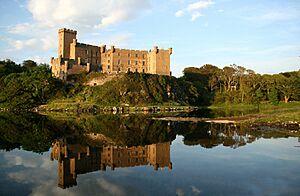
The Clan MacLeod has owned several castles. Here are some of them:
- Dunvegan Castle, on Skye, is the main home of the MacLeod chief. It dates back to the 1300s. It has a large tower and the famous Fairy Tower.
- Cadboll Castle, near Tain, Ross-shire, is now a ruined tower house. It was once held by the MacLeods of Cadboll.
- Knock Castle (Isle of Skye), also called Caisteal Camus, was held by the MacLeods in the 1400s. Later, it went to the Clan MacDonald.
- Casteal Mhicleod, near Shiel Bridge in Lochaber, is a ruined castle. It was used by Alastair Crotach MacLeod in the 1500s.
- Dunscaith Castle, near Armadale, Skye, is a ruined castle on a rock by the sea. It was first held by the MacAskills, who were part of the MacLeods. The MacLeods defended it against the MacDonalds in 1395 and 1401. But it later went to the MacDonalds.
- Duntulm Castle, near Uig, Skye, was built on an old Iron Age fort. The MacLeods once held it. In 1540, James V of Scotland visited it. But in the 1600s, it went to the MacDonalds.
- Eilean Ghrudidh, in Loch Maree, was a castle on an island. The MacLeods held it from about 1430 to 1513.
- Gunnery of MacLeod, on the Isle of Berneray, was a castle held by the MacLeods. Norman MacLeod of Berneray, a famous scholar, was born there. He fought at the Battle of Worcester in 1651.
- You can also see: Castles of the Clan MacLeod of Lewis.
Clan Heirlooms
The MacLeod chiefs have several special items at Dunvegan Castle. One of the most famous is the Fairy Flag. Many stories say it has magical powers. It was said to have saved the clan three times when it was unfurled.
Another special item is the Dunvegan Cup. This is a wooden and silver cup made in Ireland around 1493. The MacLeods likely got it in the 1500s or 1600s. This was when they helped Irish leaders fight against English forces.
There is also Sir Rory Mor's Horn. It is named after the 15th chief. Clan tradition says that every new male chief must drink from this horn in one go.
Clan Symbols
Members of Clan MacLeod can wear a crest badge. This shows they belong to the clan chief. The badge has the chief's crest and motto. The crest shows a bull's head with golden horns. It is placed between two red flags. The motto is hold fast.
Members can also wear a sprig of juniper. This is their clan badge. Clan badges are usually worn on a bonnet or on a lady's tartan sash.
Clan Tartan
| Tartan image | Notes |
|---|---|
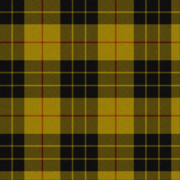 |
This is a very well-known MacLeod tartan. It is called MacLeod of Lewis or MacLeod dress. People sometimes call it "loud MacLeod" because of its bright colors. It was first linked to the Dunvegan family, not the Lewis MacLeods. It first appeared in a book called the Vestiarium Scoticum in 1842. This book has since been found to be a fake. However, the MacLeod chief had a drawing of this tartan before the book was published. Today, this tartan is officially registered. |
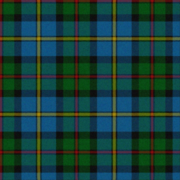 |
This tartan is sometimes called MacLeod hunting or MacLeod of Harris. It was shown in early tartan collections. This tartan comes from the Mackenzie tartan. That tartan was used in 1771 for a group of soldiers called "Lord Macleod's Highlanders". The Mackenzies claimed to be the rightful chiefs of the MacLeods of Lewis. Norman Magnus, the 26th chief, approved this tartan. The clan society adopted it in 1910. Today, this tartan is also officially registered. |
Clan Chief
Clan Septs
Septs are families or groups who were protected by a larger, more powerful clan. Scottish clans were often made up of different families who followed the same chief. The names below are considered septs of Clan MacLeod (of Dunvegan and Harris). There are also other septs for Clan Macleod of The Lewes.
| Names | Notes |
|---|---|
| Beaton, Betha, Bethune, Beton. | There is also a separate Clan Bethune. |
| Harald, Haraldson, Harold, Harrell, Harrold, Herrald, MacHarold, MacRalte, MacRaild. | |
| Andie, MacAndie, McCaskill, McCaskie, MacHandie, MacKande, MacKandy, Makcandy. | |
| MacCaig, MacCoig, MacCowig, MacCrivag, MacCuaig, MacKaig, MacQuigg. | |
| MacAlear, MacClewer, McClure, MacClure, MacLeur, MacLewer, MacLewis, Lewis, MacLur, MacLure, Clure, Cluer, Clewer. | |
| Cremmon, Crimmon, Griman, Grimman, Grimmond, MacCrimmon, MacCrummen, MacGrimman, MacGrymmen, MacRimmon. | See MacCrimmon (piping family). |
| MacKilliam, MacKullie, MacWilliam, MacWilliams, MacWillie, MacWylie, McCullie, Williamson. | Also linked to Clan Gunn. |
| Norman, Normand, Norris, Norval, Norwell, Tormud. |
In Fiction
The Clan MacLeod is well-known in the Highlander movies and TV shows. Four main characters – Connor, Duncan, Colin, and Quentin MacLeod – are all members of this clan.
See also
- Clan MacLeod of Lewis, a different part of the clan from the Isle of Lewis.
- MacCrimmon (piping family), who were the traditional bagpipers for the MacLeod chiefs.
- MacLeod, Scott GK. 2011. - MacLeod Piping Stories and Traditions and some of PM Donald MacLeod's Bagpipe Music. Academia.edu


